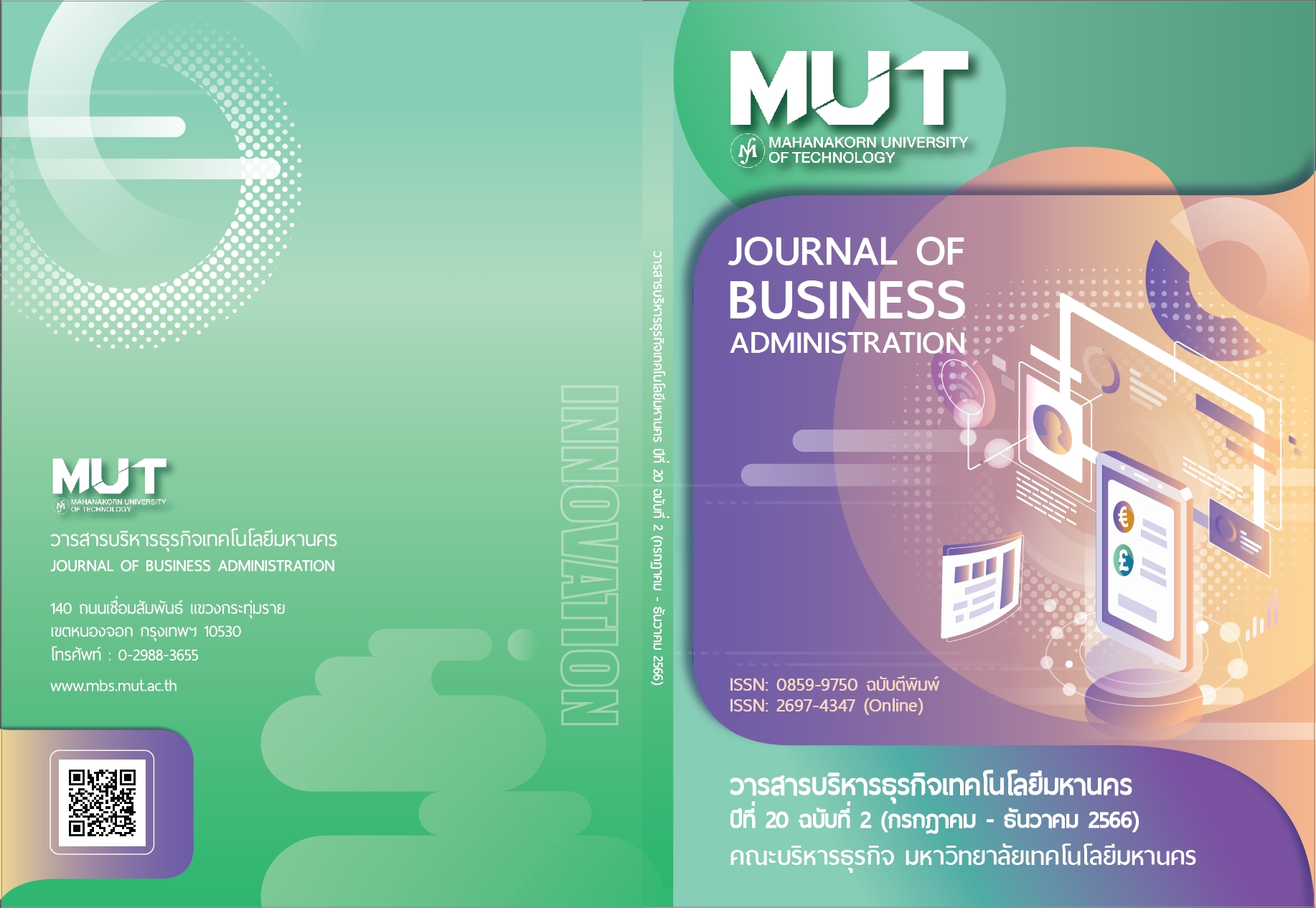Deployment of Business Model Innovation and Digital Capability to Enhance Business Opportunities for Elderly Informal Workers in Ang Thong Province
Keywords:
Business Model Innovation, Digital Capability, Competitiveness, Elderly Informal WorkersAbstract
The aims of this research were to: (1) study the elements of business model innovation and digital capability in order to improve business opportunities for elderly informal workers in Ang Thong province, (2) analyze the effects of business model innovation and digital capability on the expansion of business opportunities of elderly informal workers in Ang Thong province, and (3) evaluate the model’s congruence with the empirical data. This research implemented a quantitative research methodology using the questionnaire as a research instrument and collecting data from elderly informal workers, who participated in the community enterprise groups in Ang Thong province. A total of 360 samples were incorporated in the research. The data collection was conducted using a purposive sampling technique. The acquired data were subsequently analyzed using statistical structural models to examine the findings.
The findings of the study indicated that the model aligned with the observed data, as revealed by the statistical values of CMIN/df = 4.16, CFI = 0.96, NFI = 0.95, RFI = 0.93, TLI = 0.95, and RMSEA = 0.09. The digital capability had a significant impact on the business model innovation and competitiveness. The key components of business model innovation and digital capability were the ability to identify new opportunities digitally and the development of strong relationships with business partners, respectively. To create a business model appropriate for elderly informal workers in Ang Thong province, it is necessary to focus on fostering positive relationships with business partners, developing new methods for generating business income, and fostering positive relationships with client, etc.
Therefore, elderly informal workers who participate in community enterprise groups in Ang Thong province should pay close attention to the digital capability development because it is a factor that contributes to the essentials of business model innovation and can lead to improved competitiveness. This will enhance the business opportunities for the informal working group in Ang Thong province, leading to stability and sustainability in operation.
References
Balkyte, A. and Tvaronaviciene, M. 2010. Perception of Competitiveness in the Context of Sustainable Development: Facets of “Sustainable Competitiveness. Journal of Business Economics and Management. Vol. 11. No. 2. 341 - 365.
Bashir, M. and Verma, R. 2018. Internal Factors and Consequences of Business Model Innovation. Management Decision. Vol. 57. No. 1. 262 - 290.
Bozikova, L. and Snircova, J. 2016. A Designed Model of Sustainable Competitiveness for Slovak Industrial Companies in the Global Context of Sustainable Corporate Social Responsibility. Research Papers Faculty of Materials Science and Technology in Trnava Slovak University of Technology in Bratislava. Vol. 24. No. 37. 15 - 22.
Byrne, B. M. 1998. Structural equation modeling with LISREL, PRELIS, and SIMPLIS: Basic concepts, applications, and programming. Mahwah, NJ: Erlbaum.
Chiesa, V., Frattini, F., Lazzarotti, V. and Manzini, R. 2009. Performance Measurement in R&D: Exploring the Interplay Between Measurement Objectives, Dimensions of Performance and Contextual Factors. R&D Management. Vol. 39. No. 5. 487 – 519.
Foss, N. J. and Saebi, T. 2017. Fifteen Years of Research on Business Model Innovation: How Far Have We Come, and Where Should We Go?. Journal of Management. Vol. 43. No. 1. 200 - 227.
Gatautis, H., Vaiciukynaite, E. and Tarute, A. 2019. Impact of Business Model Innovations on SME’s Innovativeness and Performance. Baltic Journal of Management. Vol. 14. No. 4. 521 - 539.
Hair, J. F. Jr., Black, W. C., Babin, B. J. and Anderson, R. E. 2010. Multivariate Data Analysis. Upper Saddle River. NJ: Prentice Hall.
Hammer, M. and Champy, J. 1993. Re-Engineering the Corporation. New York: Harper Business.
Huang, H. C., Lai, M. C., Lin, L. H. and Chen, C. T. 2012. Overcoming Organizational Inertia to Strengthen Business Model Innovation An Open Innovation Perspective. Journal of Organizational Change. Vol. 26. No. 6. 977 - 1002.
Karimi, J. and Walter, Z. 2016. Corporate Entrepreneurship, Disruptive Business Model Innovation Adoption, and its Performance: The Case of the Newspaper Industry. Long Range Planning. Vol. 49. No. 3. 342 – 360.
Karman, A. and Savaneviciene, A. 2020. Enhancing Dynamic Capabilities to Improve Sustainable Competitiveness: Insights From Research on Organisations of the Baltic region. Baltic Journal of Management. Vol. 16. No. 2. 318 - 341.
Khan, S. H., Majid, A., Yasir, M. and Javed, A. 2020. Social Capital and Business Model Innovation in SMEs: Do Organizational Learning Capabilities and Entrepreneurial Orientation Really Matter? European Journal of Innovation Management. Vol. 24. No. 1. 191 – 212.
Khin, S. and Ho, T. C. 2019. Digital Technology, Digital Capability and Organizational Performance. International Journal of Innovation Science. Vol. 11. No. 2. 177 – 195.
Kline, R. B. 2005. Methodology in the Social Sciences: Principles and Practice of Structural Equation Modeling. New York: NY.
Latifi, M. A., Nikou, S. and Bouwman, H. 2021. Business Model Innovation and Firm Performance: Exploring Causal Mechanisms in SMEs. Technovation. Vol. 107. 102274.
Levallet, N. and Chan, Y. 2018. Role of Digital Capabilities in Unleashing the Power of Managerial Improvisation. MIS Quarterly Executive. Vol. 17. No. 1. 4 - 21.
Lidija, B. and Robert, D. H. 2014. Dynamic Capabilities vs. Innovation Capability: Are they Related?. Journal of Small Business and Enterprise Development. Vol. 21. No. 3. 368 – 384.
Madhavan, M., Sharafuddin, M. A. and Chaichana, T. 2022. Impact of Business Model Innovation on Sustainable Performance of Processed Marine Food Product SMEs in Thailand—A PLS-SEM approach. Sustainability. Vol. 14. 9673.
Martins, L. L., Rindova, V. P. and Greenbaum, B. E. 2015. Unlocking the Hidden Value of Concepts: A Cognitive Approach to Business Model Innovation. Strategic Entrepreneurship Journal. Vol. 9. No. 1. 99 – 117.
Mehra, S. 1998. Perpetual Analysis and Continuous Improvements: A must for Organizational Competitiveness. Managerial Finance. Vol. 24. No. 1. 19 – 27.
Mikalef, P. and Pateli, A. 2017. Information Technology-Enabled Dynamic Capabilities and Their Indirect Effect on Competitive Performance: Findings from PLS-SEM and fsQCA. Journal of Business Research. Vol. 70. 1 - 16.
Pedersen, E. R. G., Gwozdz, W. and Hvass, K. K. 2018. Exploring the Relationship Between Business Model Innovation, Corporate Sustainability, and Organisational Values within the Fashion Industry. Journal of Business Ethics. Vol. 149. No. 2. 267 – 284.
Porter, M. E. 1998. On Competition, Harvard Business School Press. Boston.
Pundziene, A., Nikou, S. and Bouwman, H. 2021. The Nexus Between Dynamic Capabilities and Competitive Firm Performance: The Mediating Role of Open Innovation. European Journal of Innovation Management. Vol. 25. No. 6. 152 – 177.
Rantala, T., Ukko, J., Saunila, M. and Havukainen, J. 2018. The Effect of Sustainability in the Adoption of Technological, Service, and Business Model Innovations. Journal of Cleaner Production. Vol. 172. 46 - 55.
Renko, M., Carsrud, A. and Brannback, M. 2009. The Effect of a Market Orientation, Entrepreneurial Orientation, and Technological Capability on Innovativeness: A Study of Young Biotechnology Ventures in the United States and in Scandinavia. Journal of Small Business Management. Vol. 47. No. 3. 331 - 369.
Robertson, T. S. 2017. Business Model Innovation: A Marketing Ecosystem View. AMS Review. Vol. 7. No. (3-4). 90 - 100.
Salomon, M. F. B., Mello, C. H. P., Salgado, E. G. and Bitencourt, M. 2018. Components to Construct a Business Model Innovation Under a Product-Service System Approach in the Aerospace Industry Through Analytical Hierarchy Process. Closing the Gap Between Practice and Research in Industrial Engineering. 29 – 37.
Schilke, O., Hu, S. and Helfat, C. E. 2017. Quo Vadis, Dynamic Capabilities? A Content-Analytic Review of the Current State of Knowledge and Recommendations for Future Research. The Academy of Management Annuals. Vol. 12. No. 1. 390 - 439.
Shafia, M. A., Shavvalpour, S., Hosseini, M. and Hosseini, R. 2016. Mediating Effect of Technological Innovation Capabilities Between Dynamic Capabilities and Competitiveness of Research and Technology Organisations. Technology Analysis and Strategic Management. Vol. 28. No. 7. 811 – 826.
Teece, D. J. 2010. Business Models, Business Strategy and Innovation. Long Range Planning. Vol. 43. No. (2–3). 172 – 194.
Teece, D. J. and Pisano, G. 1994. The Dynamic Capabilities of Firms: An Introduction. Industrial and Corporate Change. Vol. 3. No. 3. 537 - 556.
Teece, D. J., Pisano, G. and Shuen, A. 1997. Dynamic Capabilities and Strategic Management. Strategic Management Journal. Vol. 18. No. 7. 509 - 533.
Wang, Z. and Zhou, Y. 2020. Business Model Innovation, legitimacy and Performance: Social Enterprises in China. Management Decision. Vol. 59. No. 11. 2693 - 2712.
Westerman, G., Bonnet, D. and McAfee, A. 2012. The Digital Capabilities Your Company Needs. MIT Sloan Management Review. Retrieved April 25, 2023 from https://sloanreview.mit.edu/article/the-digitalcapabilities-your-company-needs/
Wrigley, C., Bucolo, S. and Straker, K. 2016. Designing New Business Models: Blue Sky Thinking and Testing. Journal of Business Strategy. Vol. 37. No. 5. 22 – 31.
Zahra, S. A., Sapienza, H. J. and Davidsson, P. 2006. Entrepreneurship and Dynamic Capabilities: A Review, Model and Research Agenda. Journal of Management Studies. Vol. 43. No. 4. 917 - 955.
Zhang, P. and London, K. 2013. Towards an Internationalized Sustainable Industrial Competitiveness Model. Competitiveness review An International Business Journal. Vol. 23. No. 2. 95-113.
Zhou, K. Z. and Wu, F. 2010. Technology Capability, Strategic Flexibility and Product Innovation. Strategic Management Journal. Vol. 31. No. (5-6). 547 - 561.
Downloads
Published
Issue
Section
License

This work is licensed under a Creative Commons Attribution-NonCommercial-NoDerivatives 4.0 International License.
ข้อความ ข้อคิดเห็น ข้อมูล เนื้อหา รูปภาพ แผนภูมิ แผนผัง เป็นต้น ที่ปรากฏและแสดงในบทความต่างๆ ในวารสารบริหารธุรกิจเทคโนโลยีมหานคร ถือเป็นความรับผิดชอบโดยตรงของผู้เขียนบทความนั้นๆ มิใช่เป็นความรับผิดชอบใดๆ ของวารสารบริหารธุรกิจเทคโนโลยีมหานคร และมหาวิทยาลัยเทคโนโลยีมหานคร
บทความที่ตีพิมพ์ในวารสารบริหารธุรกิจเทคโนโลยีมหานคร ถือเป็นลิขสิทธิ์เฉพาะของคณะบริหารธุรกิจ มหาวิทยาลัยเทคโนโลยีมหานคร หากบุคคลหรือหน่วยงานใดต้องการนำทั้งหมดหรือส่วนใดส่วนหนึ่งไปเผยแพร่ต่อหรือเพื่อกระทำการใดๆ จะต้องได้รับการอนุญาตเป็นลายลักษณ์อักษรจากคณะบริหารธุรกิจ มหาวิทยาลัยเทคโนโลยีมหานครก่อนเท่านั้น


